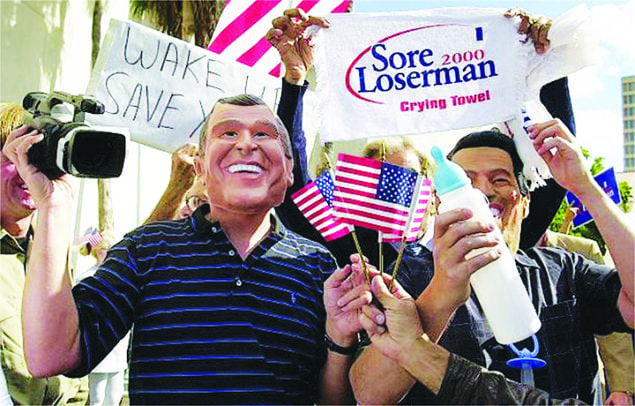 When Vice President Al Gore and Gov. George W. Bush made history in 2000 during the presidential election, Florida and Miami-Dade County were front and center as a conflict raged for 35 days and the country wondered whom they had elected their new President.
When Vice President Al Gore and Gov. George W. Bush made history in 2000 during the presidential election, Florida and Miami-Dade County were front and center as a conflict raged for 35 days and the country wondered whom they had elected their new President.
Though the popular vote for president showed Gore with a razor thin 600,000 vote lead late during the night of November 7, the Electoral College vote, which determines the state by state winner and ultimately the president-elect, was historically close. As we neared midnight, it was 246 electoral votes for Bush and 255 for Gore—with 270 needed to win the presidency. The states finishing their tallying were New Mexico (5 electoral votes), Oregon (7) and, of course, Florida (25).
Vice President Gore was declared the winner in New Mexico and Oregon, giving him a slight lead in the Electoral College with only our state of Florida’s count remaining. But Gov. Bush held an incredibly narrow lead in the Florida raw vote tally—under two thousand votes out of more than 6 million votes for president.
As midnight approached, some of the networks called Bush the winner in Florida and projected him as the next president. A final count shown on TV had a 1700 vote difference. However, a glitch was discovered in the ballots of Palm Beach County (“a boxy layout” was the term used to describe the ballots and apparent cause for unintended votes allotted to Pat Buchanan, the Reform Party candidate) and soon we had a furious contest over legalities in the voting process.
For the next five weeks, the country was in an uproar as a dramatic recount for president ensued. The protracted wrangling included a contentious protest rally held at the Clark Center in downtown Miami, as Miami-Dade attempted to re-tally its votes.
It’s too bad those political combatants couldn’t have followed the sterling example of civility set by volunteers from the local Democratic and Republican parties. As the Democratic volunteers arrived on the morning of November 7 at Precinct 751 – Kendall Christian School at 8485 SW 112 St. – the two Dem activists, Rita Fenwick and Bobbi Meyers, were armed with Gore signs but not much else.
Republican volunteers stood on one side of the school’s parking lot and waved hand-held signs for Bush, and the Democrats led by Fenwick and Meyers held ground on the opposite side. The Democrats were outnumbered and lacking in resources.
At that point a youngish Republican volunteer decided to step in. He noticed that the Dems’ signs for Gore were without sticks, so he gave the two Dem volunteers wooden sticks; he even went to the trouble to nail the signs together. Later on, he supplied water to the Democrats and offered them sandwiches.
“We were flabbergasted,” remembered Meyers. “This was a hotly contested election, and there was a good amount of hazing. Not all friendly.”
When the long day ended, Rita and Bobbi trudged back to Democratic Party headquarters on SW 117 Ave. and relayed their feel good story. It was a nice end to a very long day.
It wasn’t until December 12, 2000 that we learned who was elected 43rd President of the United States. The Supreme Court of the United States decided the outcome after hearing arguments in what became known as Bush vs. Gore. During the process, the Court stopped the recount in Florida. By the time the final vote was declared, George Bush’s margin of victory in Florida was certified as 537 votes, .001 percent.
The Democrats’ loss that year was the first time in more than 100 years the popular vote for President did not reflect the outcome. Sixteen years later it happened to the Democratic candidate again. Hillary Clinton won nearly three million more votes for president than Donald Trump, but lost the popular vote in the states of Pennsylvania, Florida, Michigan and Wisconsin.
It would be welcome indeed if today’s political battles could approximate the treatment given here by a Republican loyalist to Democratic volunteers in 2000. An R treated Ds with respect that day; not as the enemy.

About the Author
Bob Goldstein is a retired broadcaster and advertising executive who has lived in South Florida for more than forty years. He is a veteran political activist (dsdcfl.org) and a member of the South Florida Writers Association. If you would like to comment on Bob’s columns, send your response by email to robertgrimm62@yahoo.com.






